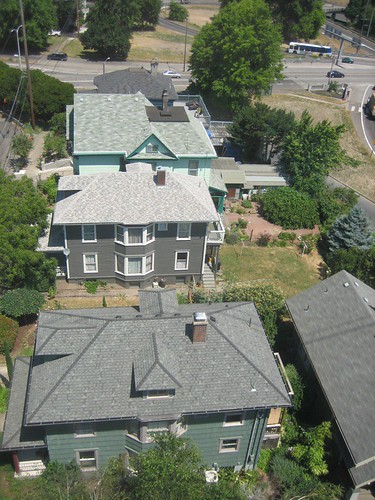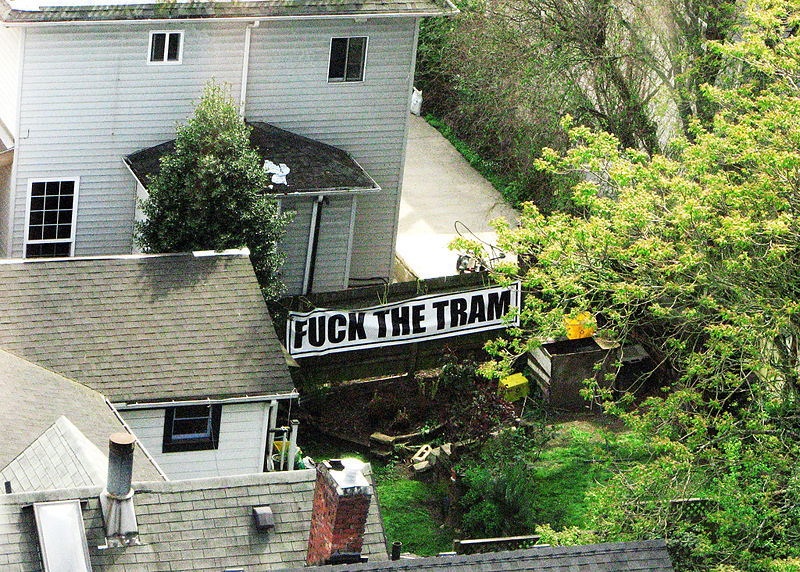Here’s an example of how not to implement Cable-Propelled Transit (CPT) in an urban area.
The Oregon Health Sciences University (OHSU) desired a direct connection between their two campuses in Portland, Oregon; one at the bottom of a mountain, another at the top. A CPT system was a logical choice. I won’t discuss what I see as a poor decision regarding the technology chosen (you can find that here), instead I wish to comment upon the route alignment.
Much to the consternation of local residents, the planners, civil engineers and politicians decided that the most logical route alignment for the Tram was overtop of a neighborhood en route to the campus. Planners failed to notice that while such alignments had worked in other locations, those locations did not fly overtop of people’s backyards.
If every there was a justifiable (and practically literal) case of NIMBYism, this was one.
Flying overtop of someone’s backyard is an invasion of someone’s private space and that presumed right to privacy is deeply ingrained in the North American psyche. Before Portland, CPT had typically be installed overtop of low-rise apartment neighborhoods without backyards. The two situations just weren’t equivalents.
Not surprisingly, the public did not react well. One resident went so far as to protest in the following way:
Listen, I’m a strong advocate of CPT, but I am in complete and 100% agreement with the owner of the above house. I also think his tactic is a fantastic example of using Portals of Entry to one’s advantage.
The beauty of CPT is that if aligned properly, it needn’t impose itself upon the urban or natural environment. Designers, engineers, planners and politicians ignored that fact and now they all have a black eye which will live on in perpetuity.
Sometimes HOW? and the WHERE? a technology is used is equally (if not more) important than WHAT? technology is used.
Creative Commons images by William Beutler and Misserion



12 Comments
Hi Steven,
Regarding NIMBY privacy issues and elevated transit.
People are used to and accept ground level traffic and the possibility that someone may be looking in their ground floor windows.
Homes usually have their bathrooms and bedrooms around the side or in the back which affords some privacy.
Otherwise, these private places are on the second or third level above the ground.
Most people don’t parade around naked in their front parlors without closing their blinds first, unless they want to be seen.
When you elevate transit to the second floor level or above, the privacy is lost.
When you bring it literally into their backyards, the privacy is lost.
However, this does not need to be the case.
I recall reading about a recent Monorail installation in Asia.
To protect the privacy of the NIMBY’s, the windows of the monorail train black out with an LCD film while the train travels past back yards and bedroom windows. While the train travels through less sensitive areas, the windows are clear.
The OHSU could adopt this high-tech solution to protect the privacy of the neighbourhoods that it passes over.
A lower tech solution is to install louvres on the Gondola windows. This would allow passengers to see to the sides or upwards, but block them from looking down.
~
~
~
~
~
All pretty good ideas! I’ve thought about similar things myself but the LCD film I’d never heard of. There’s also the question of insurance costs . . . How much more expensive would insuring a system that flew over people’s property rather than a public right of way?
Hi Steven,
Quote:
How much more expensive would insuring a system that flew over people’s property rather than a public right of way?
Reply:
LOL! You’re asking me??? You’re the expert here.
You’ll have to ask OHSU what their premium is.
Insurance generally punishes innovation.
Go back and read the article on the RIT.
http://urbanomnibus.net/2010/01/off-the-road-and-into-the-skies/
Quote:
The problem was not the cost to build the RIT. Rather it was the cost to operate it. More specifically, the cost of insurance needed to operate it. The cost of insurance on the RIT rose dramatically year after year. From 1976 to 1986, premiums rose from $800,000 to $9 million, a staggering 1,025%. This despite having an excellent safety record. Insurance costs almost exclusively made the Tram a perpetual money loser. In 1986, the insurance company added further insult to injury when they refused to renew the policy, threatening the only existing transit connection to the island. New York State stepped in and adopted a “self-insurance” policy to address the situation.
The Portland Aerial Tram (PAT) has etched glass on the lower most window panels of the cabin windows which eliminates looking straight down. Additionally, riders spend more time looking at smart phones than looking out for imaginary nude sunbathers in rainy portland.
One other thing is that the City of Portland offered to purchase, at fair market value, any house under the tram, if the owner was adequately distressed about its overhead flight path. Not one home owner took the offer. Their propertly values have ostensibly gone up due to a subsequent phase of the south waterfront development that included a $10m foot bridge connecting the flyover neighborhood to the waterfront and all transit connections.
If you could, please offer suggestions of how the PAT could have been planned better, relative to proper alignment, that would have been less intrusive. If the lower station could not move either north or south due to already existing or planned development in those areas, does a cable system planner have other choices? Also, I always thought the “shortest distance between two points” rule applied when spending barrels of cash on large transit projects.
Having said that, I really like your site. I appreciate your informed opinion on all things cable. But I would like more possible suggestions/answers following a negative view on certain systems.
Best,
ash
Hi Ash,
I’m not necessarily saying there is a better alignment. What I’m saying is that such an alignment was almost guaranteed to elicit a negative response. Having said that, there seems to be several options of approaching the site from the North near the University Hotel.
As per the public dollars argument, sometimes yes, sometimes no. The thing about cable is that while the length of the system impacts total system cost, it is somewhat (repeat: somewhat) marginal compared to station and tower infrastructure.
When you look at the history of the Portland Tram, much of the cost overruns were due to excessive customization, inaccurate geological surveys, delays caused by public outcry over the alignment and delays caused by continual last minute changes by policy-makers and politicians. Or at least that’s the story that’s been passed down over the years.
Like the Roosevelt Island Tram, I think it’s a good demonstration piece that I believe would’ve been more effective had it been implemented as a continuously circulating detachable system rather than as a shuttle-based tram. But that’s just my opinion.
Again, thanks for the discourse. Your points are valid, particularly the one about customization. I mentioned previously that the planners wanted to make a splash, which they did in more ways than just design. I believe this demonstrates how planning is often possessed by goals beyond just the pragmatic or practical. Sometimes it is “cost be damned, it’s what we want!”
With that said, the PAT has integrated nicely into the surroundings and seems accepted as a landmark worth noting.
I think your site is playing an integral role in getting others to think about cable driven transportation. Europe is so far ahead of North America when it comes to seeing these systems as viable urban alternatives to other forms of transport.
Keep rocking the posts.
Best,
ash